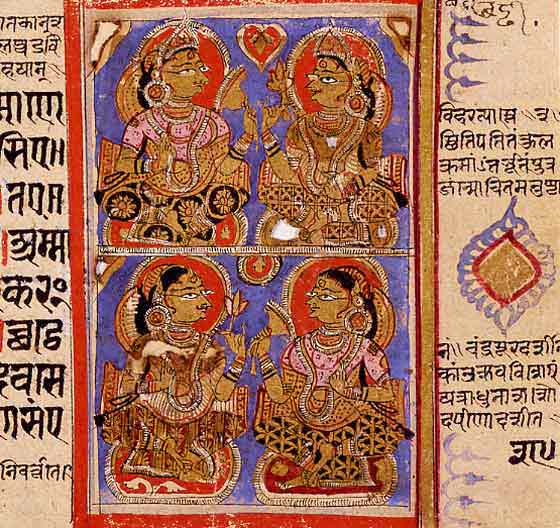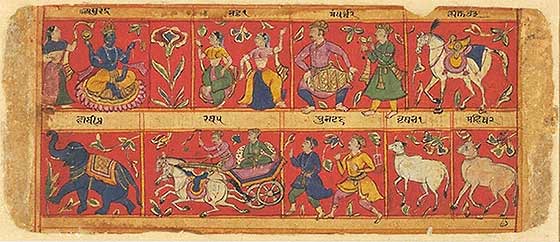The study, recitation and veneration of sacred scriptures are a primary religious focus of the Jains. Important sermons, canonical texts and commentaries were transmitted orally long before being committed to writing. Exactly when Jain texts began to be illustrated is uncertain; the oldest surviving examples date from around the 10th-11th century, but many state that they were copied from earlier texts that presumably were decaying.
The earliest Jain illuminated manuscripts are inscribed and painted on prepared palm-leaves and bound with cords passing through holes in the folios. The folios are encased in wooden covers that are often decorated with religious or historical themes. Book covers continued to be made in later centuries.
After the introduction of paper into western India from Iran around the 12th century, Jain texts were increasingly written on this new and more versatile medium. The use of paper permitted larger compositions and a greater variety of decorative devices and borders, although the format of the palm-leaf manuscript was retained. By the end of the 14th century, deluxe manuscripts were produced on paper, brilliantly adorned with gold, silver, crimson and a rich ultramarine derived from imported lapis lazuli.
The major centres of Jain manuscript production were Ahmedabad and Patan in Gujarat. Other centres included Jaisalmer, Gwalior and Delhi. The patrons were mainly Svetambara Jains, who considered the commissioning of illustrated books and their donation to Jain temple libraries (bhandars) to be an important merit-making activity.
The Cosmic and Mortal Realms
While manuscript illustrations are certainly the best-known Jain paintings to audiences outside India, there is also an extensive Jain tradition of larger paintings, from album-size to monumental paintings on cloth. The most spectacular of these are the cosmological paintings depicting the structure of the Jain universe.
The Jain cosmos is divided into three realms of virtually unfathomable proportions: the upper or celestial world, the middle or mortal world, and the lower or infernal world. The three realms are portrayed either collectively or independently in both abstract and personified representations, the latter as the cosmic man (lokapurusha) endowed with a fantastical anatomy hierarchically arranged to symbolise the three realms of creation.
Among the more abstract representations are maps of the middle world - from where liberation from the cycle of rebirth is possible. They show two-and-a-half continents, arranged concentrically and separated by blue rings that represent oceans. The central continent is called Jambudvipa, the continent of the rose-apple tree. In the south of this continent is India. At the very centre of the map stands Mount Meru, the cosmic axis.
Other large-scale Jain paintings feature esoteric deities or symbols and invocations that aid the practitioner in meditation or in initiation rites, used in the mystical Tantric methods of seeking enlightenment. Another favourite genre comprises monumental paintings of Jain pilgrimage sites, especially Mount Satrunjaya, in Gujarat. Apart from murals and temple banners, these colossal and highly detailed works are some of the largest examples of pictorial art ever created in India. These pilgrimage paintings are displayed within Jain temple complexes during a special festival at the end of the rainy season. Devotees who are unable to make the pilgrimages can receive the religious merit of visiting the sites simply by viewing their representations.
Depictions of important pilgrimage sites such as Mount Sammeda in Bihar, where 20 Jinas attained moksha or release from the cycle of rebirth, were also carved in stone. Individual scenes of religious instruction, as well as homage to the Jinas and various deities, are also popular subjects in Jain painting. Pictorial narrations of the lives of the Jinas are used to instruct the faithful through the portrayal of selfless acts.
Non-violence in Jain art
Genuine compassion requires imagination, and this is why for the Jains, art is central. The seated Tirthankara image (murti) is one of the most common icons in Jainism. It is at once serene, peaceful and balanced.
Animals and nature play a central role in temple art. For Jains, all life is precious and worthy of the highest respect. Jains believe that there cannot be human peace at the expense of harming nature or animals. One of the most iconic Jain images is that of the Samavasarana, depicting the sermon given by a Tirthankara after attaining enlightenment. While Mahavira was sharing his knowledge, all kinds of species joined the congregation, and all could clearly see Mahavira and understand the message in their own language. This event is often depicted in Jain painting and sculpture.
Figures:
 |
Jain manuscript cover depicting the fourteen auspicious dreams of Queen Trisala, Mahavira's mother, which heralded his birth.
Western India
From the earliest Jain illuminated manuscripts, the folios were encased in wooden covers that are often decorated with religious or historical themes. These book covers, such as this 19th-century example, continued to be made in later centuries. |
 |
Page from a Kalpasutra manuscript showing the birth of Mahavira.
Western India
The Kalpasutra (The Book of Ritual) is one of the two most popular texts and contains biographies of the four most significant Jinas, including Mahavira, and the Story of the Teacher Kalaka (Kalakacharyakatha), an influential moralising work frequently appended to the Kalpasutra. |
 |
Page from a Kalpasutra manuscript showing women of the royal household celebrating the sixth night after the birth of Mahavira.
Western India
The Kalpasutra (The Book of Ritual) is one of the two most popular texts and contains biographies of the four most significant Jinas, including Mahavira, and the Story of the Teacher Kalaka (Kalakacharyakatha), an influential moralising work frequently appended to the Kalpasutra. |
 |
Page from an Uttaradhyayanasutra manuscript illustrating the story of Kesi and Gautama.
Gujarat, western India
The Uttaradhyayanasutra is an important text concerned with the rules of monastic behaviour. This fine 15th-century copy of the Uttaradhyayanasutra is part of the V&A's collection. |
 |
Page from an Uttaradhyayanasutra manuscript illustrating the causes of carelessness.
Cambay, Gujarat, western India
The Uttaradhyayanasutra is an important text concerned with the rules of monastic behaviour. This fine 15th-century copy of the Uttaradhyayanasutra is part of the V&A's collection. |
 |
Page from a Samgrahanisutra manuscript
Western India, probably Rajasthan
The Samgrahanisutra is a cosmological text composed in 1136 that includes Jain ideas about the structure of the universe and the mapping of space. This page shows the influence of the prevalent Mughal style on Jain art in the early 17th century, when the Mughal empire was at its height. The V&A also has an 18th-century edition of the complete manuscript. |
 |
Jain cosmological mandala as a plan of Jambudvipa, Gujarat, Western India, 19th century. Gouache on cloth. Museum no. Circ.91-1970. |
 |
Tirtha Pata. Pilgrimage picture of Satrunjaya, Gujarat, Surat or Ahmedabad, Gujarat, Western India, about 1800. Private collection. |
 |
Panel depicting the pilgrimage sites of Sammeda-sikhara, Bihar, Jaipur, Rajasthan, Western India, 19th century. Marble. Museum no. 541-1883. |
